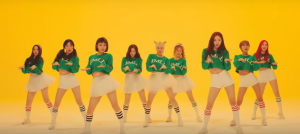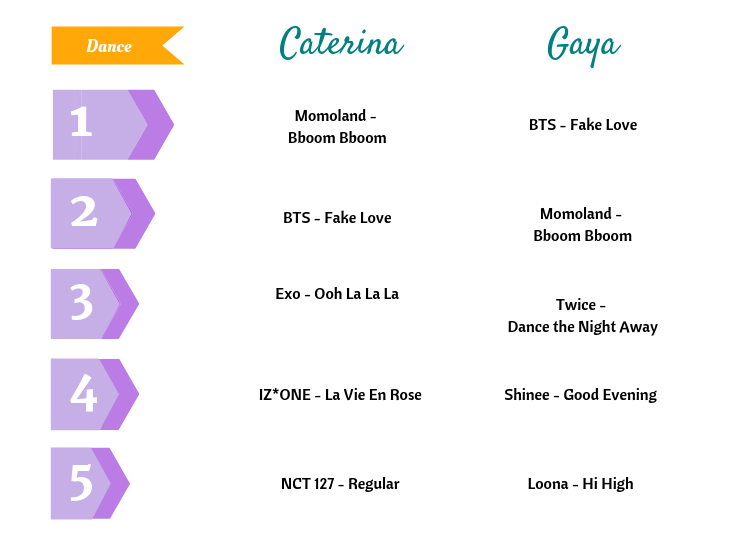
We’ve looked at debuts and comebacks; MVs and albums; K-indie and K-drama; and now we have arrived at the end of our review of 2018 with one of the most unique aspects of K-pop — dance.
The choreography was sharp and engaging as always; here, Caterina and Gaya discuss the innovations and performances of 2018.

Gaya: I love how different our lists are, even with the top two; though they are the same groups, the different order is fascinating.
Momoland’s “Bboom Bboom” was high on my list for the trend-setting point move that was replicated by a fair few groups, including Momoland itself in follow-up “Baam.” Though there are still the typical dabbing and finger hearts, everything is packaged into an engaging piece that makes it a clear marker of 2018 in K-pop.
What vaulted “Fake Love” to the top of my list, though, was the use of mirroring and pairing, as well as all those fluid contagions. Normally such moves have a subtle lead-up to them and are highlighted in a way that makes them look like stunt moves. In “Fake Love,” the rippling movements feel natural; there is no question in the viewer’s mind that this is how the dance is to be performed. Between this, the aforementioned mirroring and symbolism attached to it, this really is some of BTS’ best dance work to date. “Fake Love” is better than “Blood Sweat and Tears,” better than “Save Me,” heck it’s about as good as “Fire.”
Cate, what did you love about these two dances, and why did Momoland edge out BTS for top honour on your list?
Cate: I think it’s really interesting how our top positions actually match! While BTS’ choreography was obviously more complicated to perform, one thing I value about K-pop dances is the presence of remarkable moves. I could see how “Bboom Bboom”’s dance steps easily went viral.
Another element that I valued while ranking my favourite K-pop dances of 2018 was the way formations were used. Both Exo and Iz One (IZ*ONE) made
“Oh La La” is not Exo’s most complex dance to date, but I loved its smoothness and the formations indeed.
While my list was composed of two girl groups and three boy groups, yours was just the opposite, Gaya. Can you tell me how girl groups impacted your choice?
Gaya: I totally feel you about how smooth the “Oh La La” choreo is, you can see Exo’s years of experience in those movements! The members are all on a similar level and are able to dance together more cohesively, which only adds to the smoothness.
It’s really interesting because I personally don’t really enjoy performing feminine dances, but I do like watching them — I think that says more about my insecurity with my own femininity, but that is a conversation for another day. While the three girl group dances here definitely feel softer than other dances we’ve seen this year, they stood out to me for different reasons.
When talking about the best debuts this year, I noted that Iz One’s choreography was more accessible to casual viewers than Loona’s. The insane energy of “Hi High,” though, is difficult to ignore — it’s cute, it’s chaotic, it’s a whole lot of fun to watch! The quartet formations are also cool to see, as is that final wind-up move they do before moving into the ending pose.
Formations are also why Twice appear on my list with “Dance The Night Away.” They transition seamlessly between pairs and triplets, making the most of their nine-member make-up. Between that and the gorgeous contagions, it’s hard to not want to follow their directive and dance the night away like Twice!
I see Exo isn’t the only SM boy group to make your list, Cate, and one has snuck onto my list, too. NCT are known for their dances — what was it about NCT 127’s “Regular” that landed them a spot on your list?
Cate: I was really impressed by NCT 127’s “Regular” choreography. At
The chorus is absolutely mind blowing. They change formation in the blink of an eye with incredible smoothness and in the most natural way. The first time I’ve watched “Regular”’s dance practice I was blown away by how quickly they went from being a pyramidal formation, to a circle and then back again to a pyramid — what did just happen?!
I feel like the standard for choreographies in K-pop has risen so much in the past 7-8 years. Companies pay a lot more attention on hiring top-notch choreographers and through the years the bar has only been set higher and higher. The competition is fierce, but NCT 127 are definitely some of the best dancers in k-pop nowadays.
It’s said that K-pop’s most expensive choreography to date is actually Shinee’s “Sherlock” by Tony Testa… I see that Shinee made it to your list, Gaya. What made “Good Evening” stand out to you?
Gaya: The “Sherlock” choreo is the only good thing Tony Testa has done for K-pop, but we can discuss that elsewhere.
It’s been a while since I listened to a Shinee song in full, but there was no way I could make this list without “Good Evening.” Koharu Sugawara has been one of my favourite recent discoveries — her mix of contemporary with hip hop is amazing to watch, and I hope we see more of it in K-pop. Like Exo, Shinee has the experience to make this piece fluid and effortless. The tandem movements in the rap break is a prime example of this, as is the inclusion of chairs. I barely noticed the members moving the chairs until they were lined up perfectly — it was that “Dream Girl” mic stand incident all over again.

On a more sentimental note, it was also perfect for Shinee’s first comeback since Jonghyun’s passing. I don’t know if I could have stomached something more signature
I definitely agree that more investment has been put into K-pop choreography over the years — especially with runners for girl groups! — and it is really cool to see the growing relationship between K-pop and the wider dance community. However, I think this year shows that you don’t need big names to innovate and create hits; I’ll take a local choreographer over an international one brought in for the mediaplay any day.
Readers, what were your favourite dances from 2018, and what do you think of the dancing in general from that year? What do you think the future holds for K-pop in the dance world? Let us know your thoughts in the comments below!
(YouTube[1][2][3][4][5]. Images via Big Hit Entertainment, MLD Entertainment, SM Entertainment)

